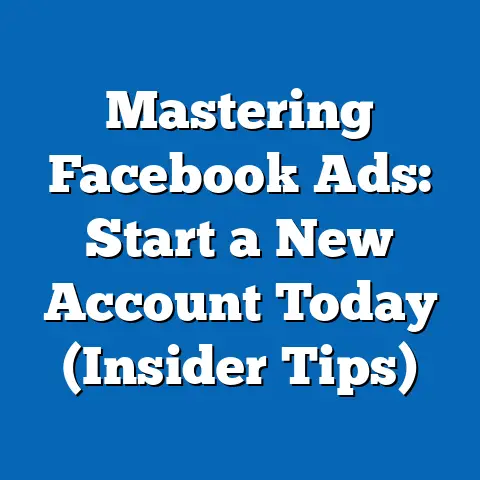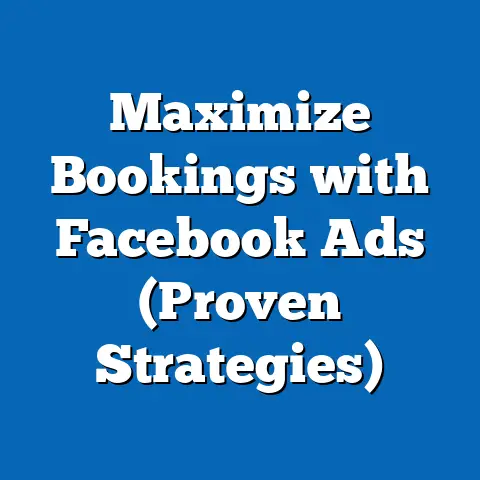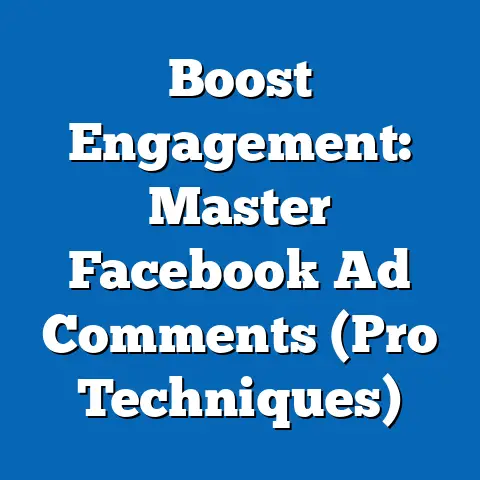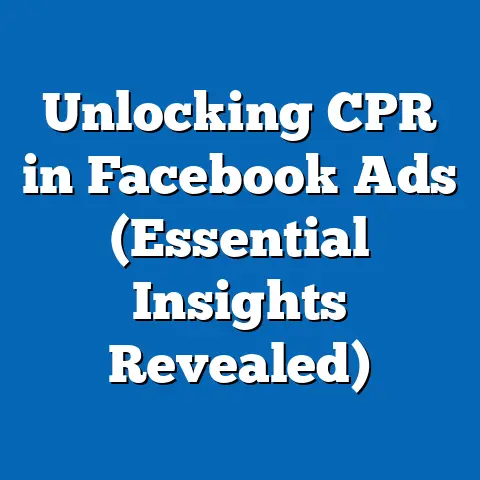Duplicate Facebook Ads Today (Pro Techniques Unveiled)
Duplicate Facebook ads—creating multiple versions of an ad to test variations or scale successful campaigns—are a cornerstone of advanced advertising strategies. This practice allows marketers to experiment with different creatives, audiences, and messaging to identify what resonates most with their target demographic. Understanding the nuances of duplication is essential for staying ahead in a platform where algorithms, user behavior, and advertising costs are constantly shifting.
This article will explore the defining characteristics of duplicate ads, trace their evolution within the context of Facebook’s advertising history, and examine their broader implications for businesses, consumers, and digital culture. We will also address the ethical considerations and potential pitfalls of duplication, ensuring a balanced perspective. Let’s begin by unpacking the core elements of duplicate ads and their significance in modern marketing.
Defining Characteristics of Duplicate Facebook Ads
At its core, duplicating a Facebook ad involves creating a copy of an existing ad or campaign to test variations or replicate success across different audiences or objectives. Unlike starting from scratch, duplication allows marketers to retain the structure of a proven ad while tweaking specific elements such as headlines, images, call-to-action buttons, or targeting parameters. This method is often employed within Facebook Ads Manager, where users can duplicate ads at the campaign, ad set, or individual ad level.
One key characteristic of duplicate ads is their role in A/B testing, a data-driven approach to optimizing ad performance. By running multiple versions simultaneously, marketers can compare metrics like click-through rates (CTR), conversion rates, and cost-per-acquisition (CPA) to determine the most effective combination of elements. Additionally, duplication is used for scaling—replicating high-performing ads to reach new audiences or increase budget allocation without disrupting the original campaign.
Another defining trait is the need for precision and strategy. Duplication is not about mindless copying; it requires a deep understanding of audience segmentation, creative fatigue, and platform algorithms to avoid diminishing returns. When done correctly, duplicate ads can amplify a campaign’s impact, but misuse can lead to wasted budgets or ad account restrictions due to policy violations such as repetitive content.
Historical Context: The Evolution of Facebook Advertising and Duplication
To fully appreciate the role of duplicate ads, it’s crucial to understand the historical trajectory of Facebook as an advertising platform. Launched in 2004 as a social networking site for college students, Facebook introduced its first advertising product, “Flyers,” in 2006, allowing businesses to target users based on basic demographic data. By 2007, the platform rolled out Facebook Ads, enabling more sophisticated targeting and ad formats, marking the beginning of its transformation into a digital marketing powerhouse.
The concept of ad duplication emerged as advertisers sought ways to optimize their campaigns in the face of increasing competition and evolving user behavior. In the early 2010s, Facebook’s introduction of the Power Editor (a precursor to today’s Ads Manager) allowed marketers to create and manage multiple ad variations more efficiently. This period also saw the rise of split testing, where duplication became a practical tool for experimenting with ad copy, visuals, and audience targeting.
Significant milestones, such as the 2012 shift to mobile-first advertising and the 2016 introduction of Dynamic Creative, further shaped duplication strategies. Dynamic Creative, for instance, automated the process of testing multiple ad components, reducing the manual effort required for duplication. Meanwhile, algorithm updates like the 2018 focus on “meaningful interactions” forced advertisers to refine their duplication tactics to avoid ad fatigue and maintain relevance.
Today, with over 2.9 billion monthly active users (as of 2023, per Meta’s reports) and an advertising revenue of $114.9 billion in 2022, Facebook remains a dominant force in digital marketing. The practice of duplicating ads has evolved from a manual, trial-and-error process to a sophisticated strategy supported by machine learning tools and analytics. Understanding this historical context highlights why duplication is not just a tactic but a reflection of the platform’s growth and the increasing complexity of online advertising.
Societal Implications of Duplicate Facebook Ads
The widespread use of duplicate Facebook ads extends beyond marketing metrics, influencing broader societal dynamics in both positive and negative ways. On one hand, duplication enables businesses—especially small and medium-sized enterprises (SMEs)—to compete in a crowded digital space by refining their messaging and reaching niche audiences cost-effectively. This democratization of advertising can foster entrepreneurship and innovation, as companies with limited budgets can test and scale campaigns without significant financial risk.
However, the practice also raises concerns about consumer experience and digital ethics. Duplicate ads, if not managed carefully, can contribute to ad fatigue, where users are bombarded with similar or repetitive content, leading to annoyance or disengagement. A 2021 study by Kantar found that 68% of social media users feel overwhelmed by the volume of ads they encounter, with repetitive messaging cited as a key frustration.
Moreover, the ability to micro-target through duplicated ads has sparked debates about privacy and manipulation. The 2018 Cambridge Analytica scandal, where user data was exploited for political advertising, underscored the risks of hyper-targeted campaigns. While duplication itself is not inherently unethical, its use in scaling misleading or exploitative content can amplify harm, particularly in contexts like political elections or public health crises (e.g., misinformation during the COVID-19 pandemic).
From a cultural perspective, duplicate ads shape how brands communicate values and trends, often reinforcing societal norms or stereotypes if not thoughtfully designed. Marketers must balance the drive for performance with responsibility, ensuring that duplicated campaigns contribute positively to the digital ecosystem. These implications set the stage for a deeper dive into the techniques, benefits, and challenges of duplicating Facebook ads.
Pro Techniques for Duplicating Facebook Ads
Mastering the art of duplicating Facebook ads requires a blend of creativity, analytical thinking, and platform expertise. Below, we outline professional techniques to leverage duplication effectively, ensuring optimal results while avoiding common pitfalls. These strategies are grounded in industry best practices and insights from digital marketing experts.
1. Strategic A/B Testing with Duplication
A/B testing remains the backbone of ad optimization, and duplication is the key to executing it efficiently. Start by identifying a single variable to test—such as the headline, image, or audience demographic—and create duplicate ads with distinct variations for each. For instance, if testing headlines, duplicate the original ad twice, changing only the headline in each version while keeping other elements (image, body text, targeting) consistent.
Run these ads simultaneously with equal budgets for a defined period (typically 3-7 days, depending on audience size and ad spend). Use Facebook’s built-in analytics to monitor performance metrics like CTR, conversion rate, and cost-per-click (CPC). According to a 2022 report by Hootsuite, campaigns with systematic A/B testing see up to a 30% improvement in ROI compared to those without.
Once a winner is identified, duplicate the high-performing ad to scale its reach or test additional variables. Avoid testing too many elements at once, as this can obscure which factor drove the results. This methodical approach ensures data-driven decisions and minimizes budget waste.
2. Audience Segmentation for Targeted Duplication
Duplication is particularly powerful when paired with precise audience segmentation. Rather than targeting a broad demographic with a single ad, duplicate the campaign to create tailored versions for distinct audience segments based on interests, behaviors, or geographic locations. For example, a clothing brand might duplicate an ad for winter jackets, customizing the messaging for urban professionals in cold climates versus outdoor enthusiasts in mountainous regions.
Facebook’s Audience Insights tool can help identify these segments by analyzing user data and suggesting relevant targeting options. A study by Social Media Examiner (2023) found that segmented campaigns achieve 25% higher engagement rates on average compared to generic ones. When duplicating for segmentation, ensure each ad set has a unique value proposition while maintaining brand consistency to avoid confusion.
3. Scaling Successful Campaigns with Duplication
Once an ad proves successful, duplication offers a seamless way to scale its impact without disrupting the original campaign. Within Ads Manager, duplicate the high-performing ad set or campaign, then gradually increase the budget (Meta recommends a 20-50% increase every 48-72 hours to avoid algorithm resets). Alternatively, duplicate the ad to test new audiences or placements, such as Instagram Stories or the Audience Network.
Scaling requires vigilance to prevent performance drops due to audience overlap or creative fatigue. Use Facebook’s “Reach and Frequency” tool to monitor how often users see your ad and pause duplicates if frequency exceeds 3-4 impressions per user within a week. Digital marketing expert Neil Patel notes that scaling too quickly can trigger a “learning phase” reset in Facebook’s algorithm, leading to higher costs and lower efficiency.
4. Avoiding Ad Fatigue with Creative Refresh
Ad fatigue—when users grow tired of seeing the same content—can undermine even the best-duplicated campaigns. To combat this, regularly refresh creative elements in duplicated ads, such as swapping images, updating copy, or testing new video formats. For instance, if a static image ad starts underperforming after two weeks, duplicate it and replace the image with a short video highlighting the same product.
Meta’s 2022 Advertising Guidelines suggest refreshing creatives every 7-14 days for optimal engagement, especially for high-frequency campaigns. Track metrics like frequency and engagement rate in Ads Manager to identify early signs of fatigue. This technique ensures duplicated ads remain relevant and compelling to viewers over time.
5. Leveraging Dynamic Creative for Automated Duplication
Facebook’s Dynamic Creative feature automates the duplication and testing process by combining multiple ad components (headlines, images, descriptions) into various permutations. Marketers upload up to 5 headlines, 5 images, and 5 descriptions, and the platform generates and tests different combinations to identify the most effective mix. This is particularly useful for businesses with limited time or resources for manual duplication.
A 2021 case study by Meta showed that campaigns using Dynamic Creative achieved a 34% lower cost-per-conversion compared to traditional A/B testing. However, experts caution that Dynamic Creative works best for broad audiences and may not suit highly specific or niche campaigns requiring tailored messaging. Use this tool as a starting point, then manually duplicate and refine winning combinations for greater control.
Benefits of Duplicating Facebook Ads
The strategic use of duplicate ads offers several advantages for marketers aiming to optimize their campaigns. First, it accelerates the testing process, allowing businesses to identify winning strategies faster than creating new ads from scratch. This efficiency is critical in a platform where ad costs can fluctuate rapidly based on competition and seasonality.
Second, duplication enables precise scaling, helping brands expand their reach without risking the performance of original campaigns. By replicating success across new audiences or markets, businesses can maximize ROI while maintaining control over variables. For SMEs, this can be a game-changer, as it levels the playing field against larger competitors with bigger budgets.
Third, duplicated ads provide valuable data insights. Each variation serves as a mini-experiment, revealing what resonates with different demographics or in different contexts. Over time, this data builds a knowledge base that informs future campaigns, reducing guesswork and enhancing strategic planning.
Challenges and Pitfalls to Avoid
Despite its benefits, duplicating Facebook ads comes with challenges that require careful navigation. One major risk is audience overlap, where duplicated ads target the same users, leading to higher frequency and potential annoyance. To mitigate this, use exclusion targeting in Ads Manager to ensure distinct audience pools for each duplicate.
Another pitfall is policy violations. Facebook’s advertising policies prohibit repetitive or low-quality content, and excessive duplication without meaningful changes can trigger ad rejections or account suspensions. A 2023 report by WordStream highlighted that 15% of advertisers faced policy issues due to improper duplication practices. Always review Meta’s guidelines before scaling or testing.
Creative fatigue, as mentioned earlier, is a persistent challenge. Even with refreshed creatives, duplicated ads can lose effectiveness if overexposed. Monitor performance metrics closely and pause underperforming duplicates to reallocate budgets effectively. Finally, over-reliance on duplication can stifle innovation; marketers must balance testing with original content creation to keep campaigns fresh and engaging.
Ethical Considerations in Duplicating Ads
The ethical dimension of duplicate ads cannot be overlooked, especially given the power of targeted advertising to influence behavior. Marketers must ensure that duplicated campaigns adhere to transparency standards, clearly disclosing sponsored content and avoiding deceptive practices. For instance, duplicating ads to promote false claims or unverified products can erode consumer trust and damage brand reputation.
Privacy is another critical concern. While duplication itself does not inherently violate privacy, its use in hyper-targeted campaigns raises questions about data usage. The 2021 introduction of Apple’s App Tracking Transparency (ATT) framework, which limits data tracking on iOS devices, has already impacted Facebook ad performance, with Meta reporting a $10 billion revenue loss in 2022 due to reduced targeting capabilities. Marketers must prioritize consent and comply with regulations like GDPR (General Data Protection Regulation) when duplicating ads for segmented audiences.
Finally, consider the societal impact of duplicated messaging. Ads that reinforce harmful stereotypes or contribute to information overload can have unintended cultural consequences. Ethical duplication involves balancing performance goals with a commitment to positive, inclusive communication.
Implications for Businesses, Consumers, and Digital Culture
The practice of duplicating Facebook ads has far-reaching implications across multiple domains. For businesses, it offers a pathway to greater efficiency and competitiveness in digital marketing. By mastering duplication, companies can optimize budgets, improve targeting, and drive conversions, ultimately strengthening their market position. However, they must invest in ongoing learning to keep pace with platform updates and algorithm changes.
For consumers, duplicate ads shape their online experience, often determining the relevance and quality of content they encounter. Well-executed duplicates can enhance user satisfaction by delivering personalized, valuable messaging, but poorly managed ones risk alienating audiences through repetition or irrelevance. As users become savvier, their expectations for authentic, non-intrusive advertising will continue to rise.
In terms of digital culture, duplicate ads reflect broader trends in how technology mediates communication and commerce. They underscore the shift toward data-driven decision-making and the increasing role of automation in marketing. At the same time, they highlight tensions around privacy, consumer autonomy, and the saturation of digital spaces with commercial content. These dynamics will likely intensify as platforms like Facebook evolve and new technologies (e.g., AI, augmented reality) reshape advertising.
Forward-Looking Insights: The Future of Duplicate Ads
Looking ahead, the future of duplicate Facebook ads will be shaped by several emerging trends and uncertainties. Advances in artificial intelligence and machine learning are expected to further automate and refine duplication processes, enabling real-time optimization of ad variations based on user behavior. Meta’s continued investment in AI-driven tools suggests that manual duplication may become less common, replaced by algorithms that predict and execute optimal ad combinations.
However, regulatory pressures around data privacy and advertising transparency will likely impose new constraints. The global push for stricter laws, such as the EU’s Digital Services Act (DSA), could limit the granularity of targeting and data usage, forcing marketers to rethink duplication strategies. Additionally, user backlash against ad saturation may drive demand for less intrusive formats, challenging the effectiveness of high-frequency duplicated campaigns.
Another uncertainty is the impact of platform competition. As TikTok, YouTube, and other social media giants vie for advertising dollars, Facebook may introduce new features or pricing models that alter the duplication landscape. Marketers must remain agile, adapting to cross-platform trends while leveraging duplication to maintain a competitive edge.
Finally, the rise of community-driven and value-based marketing suggests that future duplication will need to prioritize authenticity over sheer volume. Consumers increasingly gravitate toward brands that align with their values, and duplicated ads must reflect this shift by focusing on meaningful engagement rather than repetitive exposure. While the specifics remain unclear, one thing is certain: the ability to duplicate ads effectively will remain a vital skill in the ever-changing world of digital advertising.
Conclusion
In conclusion, duplicating Facebook ads is a powerful strategy that, when executed with precision and ethical consideration, can significantly enhance digital marketing outcomes. This article has explored the defining characteristics of duplicate ads, their historical evolution within Facebook’s advertising ecosystem, and the professional techniques that drive success. From A/B testing and audience segmentation to scaling and creative refresh, these methods offer a roadmap for optimizing campaigns in a competitive landscape.
We’ve also examined the societal implications, highlighting the balance between business benefits and consumer concerns like ad fatigue and privacy. The challenges of duplication—ranging from policy violations to creative fatigue—underscore the importance of strategic planning and continuous monitoring. Moreover, ethical considerations remind us that the pursuit of performance must not come at the expense of trust or cultural impact.
As we look to the future, the role of duplicate ads will evolve alongside technological advancements, regulatory changes, and shifting user expectations. Marketers who embrace adaptability, prioritize data-driven insights, and commit to responsible practices will be best positioned to thrive. While uncertainties remain, the principles and techniques unveiled in this analysis provide a foundation for navigating the complexities of duplicate Facebook ads today and beyond.






